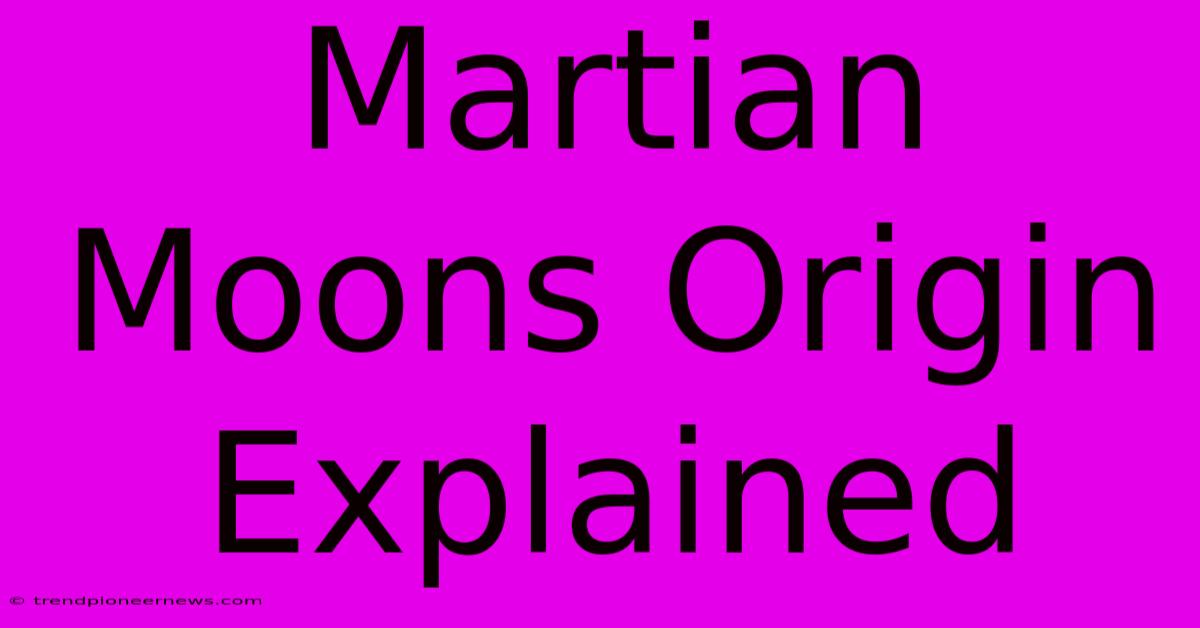Martian Moons Origin Explained

Discover more detailed and exciting information on our website. Click the link below to start your adventure: Visit Best Website Martian Moons Origin Explained. Don't miss out!
Table of Contents
Martian Moons Origin Explained: A Wild Ride Through Space!
Hey everyone! So, you're curious about Phobos and Deimos, Mars's kinda weird moons? Me too! I used to think they were just…there. Like, poof, suddenly they existed orbiting the red planet. Boy, was I wrong! Turns out their origins are way more complicated and fascinating than I ever imagined. Let's dive in, shall we?
The Capture Theory: A Gravitational Tug-of-War
For a long time, the leading theory was that Phobos and Deimos were captured asteroids. Imagine this: these space rocks are drifting through the solar system, minding their own business, when whoosh – Mars's gravity snags them. It's like a cosmic game of catch, but with way higher stakes.
This theory made sense, initially. Both moons are oddly shaped – not perfectly spherical like our own moon. They also have relatively low densities, which is typical of asteroids.
However, there were problems. Capturing an asteroid is surprisingly difficult. It requires just the right combination of speed and trajectory, and the chances of it happening are pretty slim. Like, winning the lottery slim. Scientists started to question this simple explanation. Their current orbits are also really peculiar, very close to Mars's equator. This suggests a more complex event played a role.
The Giant-Impact Hypothesis: A Cosmic Collision
Then came the giant-impact hypothesis – a much more dramatic story. This theory suggests that Phobos and Deimos are the remnants of a much larger object that collided with Mars billions of years ago. Think of it as a mega-smashup, the kind that could leave behind a scattering of debris. Some of this debris, over time, coalesced to form the moons we see today.
This theory better explains the moons' orbits and compositions. The relatively low density could be explained by the fragmentation process. Moreover, recent spectroscopic analysis reveals some similarities between the Martian surface and the moons – further support for the theory.
There's still a lot we don't know about Phobos and Deimos. Scientists are still gathering data to refine these theories. But what we do know is super cool!
Phobos: A Closer Look (and a ticking time bomb?)
Phobos, the larger of the two moons, is spiraling closer to Mars. Scientists predict it will either crash into Mars or break apart into a ring system within the next 50 million years. That's like, totally mind-blowing! It's a cosmic race against time.
Deimos: The More Mysterious Moon
Deimos is smaller and farther away, making it less well-understood. It’s darker and more cratered than Phobos. It's a little more mysterious, and scientists are still studying its unique features. Maybe someday, we'll uncover more secrets of this distant moon.
What have I learned?
This whole journey of learning about the Martian moons has taught me a few things. First, scientific theories are constantly evolving. We'll need more data, advanced tools and technology to get an even better understanding. Second, the universe is full of surprises. And third? I need to brush up on my astrophysics. This stuff is way more complex than I initially thought! But it's also incredibly exciting to ponder all these different ideas and theories!
This is just the tip of the iceberg when it comes to the origin of the Martian moons. Stay curious, keep exploring and you just might become the next person to add to our understanding of space!

Thank you for visiting our website wich cover about Martian Moons Origin Explained. We hope the information provided has been useful to you. Feel free to contact us if you have any questions or need further assistance. See you next time and dont miss to bookmark.
Featured Posts
-
Man City Feyenoord Champions League
Nov 27, 2024
-
Kobe Mariners Live Stream Afl Match
Nov 27, 2024
-
6 4 Magnitude Quake Hits Japans Noto
Nov 27, 2024
-
Halton Petition General Election
Nov 27, 2024
-
Award Winning Coach
Nov 27, 2024
